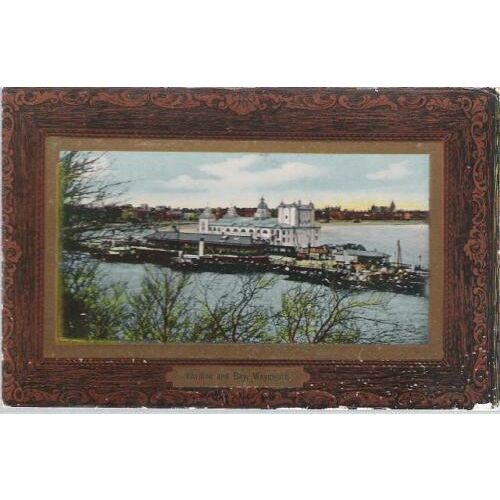Weymouth, Dorset - Pavilion & Bay - wood frame effect postcard c.1905-10
- Condition : Used
- Dispatch : 2 Days
- Brand : None
- ID# : 182652806
- Quantity : 1 item
- Views : 136
- Location : United Kingdom

- Seller : justthebook (+1704)
- Barcode : None
- Start : Tue 18 Jun 2019 12:00:17 (BST)
- Close : Run Until Sold
- Remain : Run Until Sold
More Listings from This Seller view all
Seller's Description
- Postcard
- Picture / Image: Pavilion and Bay, Weymouth [Dorset] - has wood frame effect
- Publisher: 'The Royal Series' / Ettinger's Weymouth series 1201/5
- Postally used: no
- Stamp: n/a
- Postmark(s): n/a
- Sent to: n/a
- Notes / condition:
Please ask if you need any other information and I will do the best I can to answer.
Image may be low res for illustrative purposes - if you need a higher definition image then please contact me and I may be able to send one. No cards have been trimmed (unless stated).
------------------------------------------------
Postage & Packing:
Postage and packing charge should be showing for your location (contact if not sure).
No additional charges for more than one postcard. You can buy as many postcards from me as you like and you will just pay the fee above once. Please wait for combined invoice. (If buying postcards with other things such as books, please contact or wait for invoice before paying).
Payment Methods:
UK - PayPal, Cheque (from UK bank) or postal order
Outside UK: PayPal ONLY (unless otherwise stated) please. NO non-UK currency checks or money orders (sorry).
NOTE: All postcards are sent in brand new stiffened envelopes which I have bought for the task. These are specially made to protect postcards and you may be able to re-use them. In addition there are other costs to sending so the above charge is not just for the stamp!
I will give a full refund if you are not fully satisfied with the postcard.
----------------------------------------------
Text from the free encyclopedia WIKIPEDIA may appear below to give a little background information (internal links may not work) :
*************
The Weymouth Pavilion, formerly the Ritz, is a theatre in Weymouth, Dorset. The complex contains a 988-seat theatre, 600 (maximum) capacity ballroomknown as the Ocean Room, the Piano Bar restaurant, Ritz Cafe and other function and meeting rooms.[1]
Originally constructed in 1908, it was destroyed in a building fire in 1954 and the current theatre was built in its place in 1958.[2] The theatre was owned and operated by Weymouth & Portland Borough Council until 2013 and is now operated by a not-for-profit Community Interest Company.[3] The theatre is located at the end of The Esplanade between Weymouth Harbour and Weymouth Beach. The Jurassic Skyline is also located in this area.
By the beginning of the 20th century, Weymouth was becoming increasingly popular as a seaside resort. The large demand for entertainment was put forward to Weymouth and Melcombe Regis Borough Councillors. Many people believed that if Weymouth was to flourish as a first-class resort, a venue was urgently required and so by 1906, the decision was made to build the Weymouth Pavilion. The site chosen was at the southern end of the Esplanade, and this caused some objections to be made, including that it was a location too far from the railway station and that the area was particularly exposed to bad weather. Despite this, the plans went ahead and the area was reclaimed from the foreshore. In 1907, an architectural competition was launched to find a design, and in October that year, the winning design from an anonymous hand was chosen. It included an auditorium with stalls and gallery seating, an Oriental café and outside verandahs. The building's frame was of steel with the main fabric of wood. The construction began in early 1908 and was completed that year at a total cost of £14,150, including land reclamation.[4]
The Pavilion had its grand opening on 21 December 1908, and included the presence of the Earl and Countess of Shaftesbury. A special train from London bought down metropolitan journalists. Two nights later the venue hosted its first performance, a Christmas pantomime, Mother Goose. The Pavilion's mainstay during the early years was the Pavilion Orchestra under Mr John Howgill, who would put on concerts in the theatre and performed in the Tea rooms. The outbreak of the First World War in 1914 brought major changes to the Pavilion as the town council came to the decision that they should not be running the venue and therefore leased it to Ernest Wheeler - a member of a prominent business family in Weymouth. Wheeler carried on leasing the building for the next 25 years.[5] During the 1920s and 1930s, the venue hosted a mixture of events including musical comedies and matinee performances of operatic arias. During the 1930s, Wheeler decided to review his operations at the Pavilion, due to the increasing competition from the Alexandra Gardens Theatre, which had opened in 1925, as well as the changing of public taste. As a result, Wheeler got the Town Council to agree to the adaptation of the Pavilion auditorium to enable him to screen films. This was accepted and the Pavilion became a popular cinema in the town. Around this time, although sometimes reputed to be during the 1950s, some additional land reclamation allowed the area to be extended, and the venue's length was extended.[6]
The Pavilion closed during the Second World War as it was requisitioned by the military for war purposes, largely for the newly formed No. 4 Commando, who formed in Weymouth on 21 July 1940, when the first intake of 500 volunteers arrived. Lieutenant Colonel C.P.D Legard and the Regimental Sergeant Major W. Morris held their first parade on 22 July 1940, at Weymouth Pavilion.[7] In 1940 it was used to house 800 Moroccans from the French army and was then later used as a medical centre during the evacuation of the Channel Islands. During the war, military authorities put forward the idea of demolishing the building under defence regulations, however this plan never came to fruition. The venue was damaged in an air raid in April 1942 and was then taken over by the Admiralty. After the end of the war, the building remained in use of the Admiralty, and was used as a sorting office for naval post. The Town Council did not get the building back until 1947, who then spent two years attempting to get compensation for building damage during its use in the war.
In 1947, the council had leased the venue to the Buxton Theatre Circuit who in 1949 spent £4000 installing a new cinema projection room. Finally, the Pavilion re-opened to the public in May 1950 under a new name, The Ritz Theatre, and the first film shown to the public was The Forsyte Saga. In September 1951, The Ritz saw a new management company, Melcombe Productions, who took over and put on live theatre, particularly during the summer season, as well as a pantomime at Christmas.
Due to inadequate immediate post-war repairs to the venue, the current management decided to renew the roof as well as redecorating the wooden exterior. Work began in January 1954, and a variety programme re-opened the building in March before the repairs had been finished. On the afternoon of 13 April 1954, the building caught fire during refurbishment and ended up destroying much of the building, with the only remaining parts being the foyer and Palm Court. The theatre took little more than an hour to burn despite the efforts of ten fire pumps from the Dorset county, and a large gathering of the public of Weymouth turned out to watch the situation. The total costs of damages were estimated to be £80,000. It was later discovered that the fire was caused by the misuse of a blow-lamp, which had removed the many layers of paint on the wooden exterior. The members of the Fire Brigade felt that enough of the building was saved for it to be reconstructed, however the local council put forward a claim on the fire insurance policy and the site was cleared.[8]
*********
Listing Information
| Listing Type | Gallery Listing |
| Listing ID# | 182652806 |
| Start Time | Tue 18 Jun 2019 12:00:17 (BST) |
| Close Time | Run Until Sold |
| Starting Bid | Fixed Price (no bidding) |
| Item Condition | Used |
| Bids | 0 |
| Views | 136 |
| Dispatch Time | 2 Days |
| Quantity | 1 |
| Location | United Kingdom |
| Auto Extend | No |




 for 1 item(s)
for 1 item(s)











